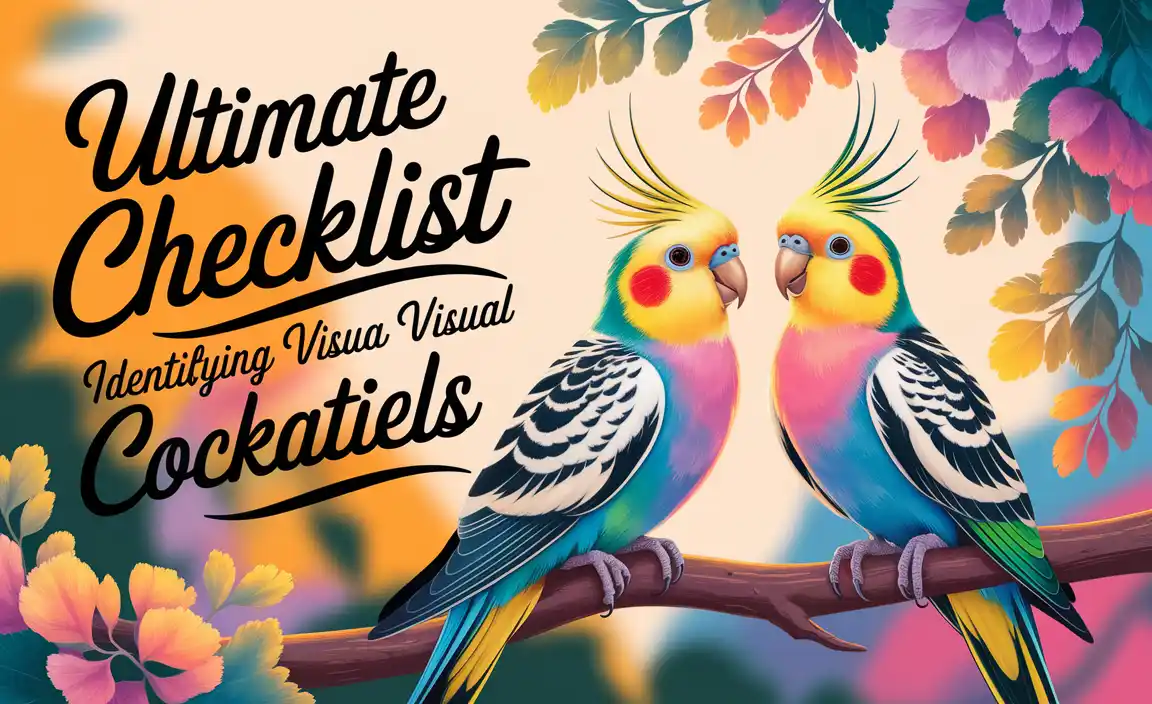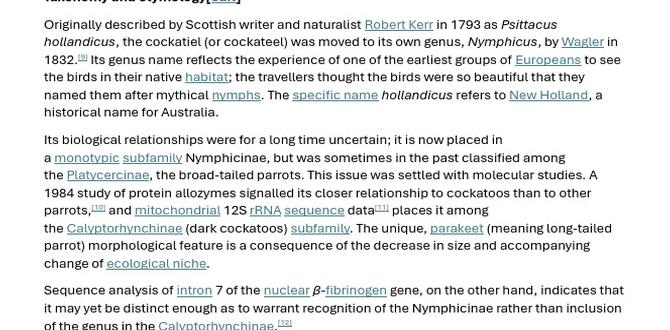Have you ever wondered how to tell one cockatiel from another? Imagine you have a whole room of these charming birds, and you need to find a special one. How do you do it? It’s not magic; it’s all about knowing what to look for. Let’s dive into a simple checklist for visual cockatiel identification that makes it fun and easy. Did you know that cockatiels have cheek patches that come in different colors? Now, think about their playful crests that stand tall when they are happy. Isn’t that cool? These little details hold the secrets to spotting each unique bird. Want to be a cockatiel expert? Start by learning this checklist to become a pro at cockatiel identification in no time!

Comprehensive Checklist For Visual Cockatiel Identification

Checklist for Visual Cockatiel Identification
Ever wonder how to spot a cockatiel? Let’s dive into a checklist to help you! Cockatiels have vibrant cheek circles, much like a classic clown face. Their adorable head crests rise whenever curious. Look for a mix of grey bodies with yellow and white splashes. Male cockatiels show bold colors, while females often appear softer. This charming bird can whistle and mimic sounds. Isn’t that amazing? Watch them fluff their feathers in joy – sheer happiness!
Color Variations in Cockatiels
Commonly seen color mutations. Influence of genetics on cockatiel colors.
Cockatiels come in many colors. This happens because of their genetics. Some common color mutations include:
- Normal Grey: The most common cockatiel, with grey feathers.
- Lutino: Bright yellow with red eyes.
- Pied: Mix of grey and yellow patches.
Genes decide these colors. They pass traits from parents to chicks. Fun fact: A single gene swap can change a cockatiel’s appearance!
What causes color differences in cockatiels?
Genes and mutations are the main reasons. Genes passed from parents decide what color a baby cockatiel will be. Mutations add variety by introducing new colors.
Are all cockatiels the same color?
No, they can be grey, yellow, or a mix. Their color depends on their parents’ genes and any mutations that might occur.
Recognizing Cockatiel Gender by Appearance
Notable differences between male and female cockatiels. Challenges in visual gender identification.
It can be tricky to tell if a cockatiel is a boy or a girl. There are key differences to look for, but they aren’t always clear. For males, their cheeks are bright orange, and they often have stronger facial markings. Females tend to have a duller color with bars under their tails. But, sometimes, both males and females can look the same, especially when they’re young. So it’s best to combine visual clues with behavior to make sure.
What are clear signs of a male cockatiel?
Male cockatiels show bold colors and patterns. They often have bright orange cheeks and a striking yellow head. Their tail feathers are more even without bars. Males usually sing and whistle more than females.
How can you tell if a cockatiel is female?
Female cockatiels usually have more muted colors. They have barred markings under their tails and wings. Their cheeks are less bright, with more gray mixed in. Females are often quieter than males.
Understanding the gender of your cockatiel can help in caring for them. Boys and girls might need different things or have different behaviors. Watching and knowing these differences makes us better bird friends.
Identifying Cockatiel Age through Plumage
Juvenile vs. adult feather patterns. Signs of aging in cockatiels.
Baby cockatiels have softer, fuzzier feathers. These feathers look less defined in color. Adults have brighter and more distinct feather patterns. Mature birds often show clear spots and stripes. As cockatiels age, their feathers lose brightness and may become a bit ragged. Older cockatiels can have a more worn appearance. Spotting these differences helps identify bird ages easily.
How can you tell the age of a cockatiel by its feathers?
Juvenile cockatiels generally have fluffy and less colorful feathers. Adult cockatiels, however, show more vibrant colors and sharper patterns. As they grow older, their feathers may appear dull and worn. By observing these changes, you can estimate their age.
- Young: Fluffy, soft feathers
- Adult: Bright, sharp patterns
- Old: Dull, worn feathers
Why do older cockatiels look different?
Age affects a cockatiel’s appearance in several ways. Their feathers can lose shine and become frayed. Changes in plumage are common as they mature, altering their look significantly. Older birds also have unique aging signs like losing vibrant hues and having slightly ragged feathers.
Special Considerations for Albino and Lutino Variants
Visual identification of albino cockatiels. Distinctive traits of lutino cockatiels.
Albino cockatiels are like the unicorns of the bird world! They are completely white with red or pink eyes. This makes them stand out in any bird crowd. With their snowy feathers, spotting them is easy even on a rainy day. Lutino cockatiels, on the other hand, go for the golden look. They have sunny yellow feathers and enchanting red eyes.
Here’s a handy guide to spot the difference:
| Type | Color | Eye Color |
|---|---|---|
| Albino | White | Red or Pink |
| Lutino | Yellow | Red |
Remember, if it looks like a snowball, it’s probably an albino. If it looks like sunshine, it’s likely a lutino. It’s like picking ice cream flavors, except these ones can fly!
Assessing Health and Wellness from Visual Cues
Indicators of a healthy cockatiel. Warning signs of illness in plumage and posture.
Look at your cockatiel. Does it appear lively? Healthy cockatiels have bright eyes and smooth feathers. They sit upright and preen often. Signs like fluffed feathers or a drooping head can signal a problem.
- Clear eyes
- Sleek plumage
- Energetic behavior
- Proper posture
mean wellness. If your bird’s feathers are ruffled or dull, it may be sick.
What are key signs of cockatiel health?
Brightness and smoothness in feathers are signs of health. Bright, clear eyes and active movement are also positive.
When to console the vet?
If your bird appears puffed up, lethargic, or has a droopy posture, see a vet right away. Early action is critical!
Taming and Personality Markers in Appearance
Behaviors indicating personality traits. Visual clues of a cockatiel’s temperament.
Cockatiels come with a variety of personalities. They show them through their behavior and look. A friendly cockatiel might chirp often, showing a lively nature. Look for smooth feathers; they often mean the bird feels relaxed. A shy cockatiel may keep its crest flat and stay quiet.
- Fluffy feathers often show comfort.
- Flat crest could mean unease.
- A raised crest shows it’s curious.
How can you tell if a cockatiel is scared?
A scared cockatiel often stays still or hides. Its feathers might appear tight, and the crest is flattened. Quietness is common, too, when they feel anxious or stressed.
Using Visual Identification in Breeding Practices
Selecting mates based on physical characteristics. Importance of visual markers in genetic planning.
Imagine hosting a cockatiel beauty contest where each feather counts! Breeders often pick mating pairs by examining their plumage colors and patterns. These visual checks help predict the colors and traits of baby birds. Breeding with a plan isn’t just whims and feathers; it’s about genetic strategy. Spotting these markers can lead to charming baby cockatiels with desirable traits.
| Characteristic | Purpose |
|---|---|
| Color | Determines potential plumage shades |
| Size | Ensures healthy growth traits |
| Feather Pattern | Predicts unique designs |
Why does this matter? These choices can shape generations, mixing in flair and a bit of sparkle. To sum up, visual cues are like clues on a treasure map. They guide breeders to discover and refine those perfect, pretty pairs. And, in the world of cockatiels, a sprinkle of gold or a dash of white makes all the difference!
Conclusion
Identifying cockatiels is fun and easy with a checklist. Look for their cheek spots, crested heads, and color variations. Use your checklist to spot these features. You can practice with friends or visit a bird sanctuary. Keep exploring to learn more about these wonderful birds and enjoy discovering new traits along the way!
FAQs
What Are The Key Physical Characteristics To Look For When Identifying A Cockatiel By Its Appearance?
To spot a cockatiel, look for its bright yellow face and crest that looks like a little feather hat. They have orange circles on their cheeks, like blush. Cockatiels usually have gray bodies and white bars on their wings. Their long tail feathers make them easy to recognize too!
How Can You Distinguish Between Male And Female Cockatiels Through Visual Cues?
You can tell male and female cockatiels apart by their colors. Male cockatiels usually have bright yellow faces and orange patches on their cheeks. Females often have more grey on their faces and less bright cheek patches. Also, females might have striped or dotted patterns under their tail feathers. So, when you look closely, you can see these differences!
What Are The Common Color Mutations Found In Cockatiels, And How Do They Affect Identification?
Cockatiels are small, colorful birds that can have different color mutations. Some common ones are Lutino, which is yellow with no grey; Pied, with a mix of yellow and grey; and Pearl, where their feathers have small, pretty dots. These colors make it easier to tell individual birds apart because they look different from the regular grey cockatiels. It’s like how we all have different hair colors or freckles that make us special!
Are There Any Specific Markings Or Features That Can Help Differentiate A Cockatiel From Other Similar Parrot Species?
Yes, you can spot a cockatiel by its special features. Cockatiels have a cute, pointy crest on their heads. They also have bright orange circles, like cheeks, on their faces. Their bodies are mostly grey with white patches on their wings. These things make them look different from other parrots.
How Does Age Affect The Visual Identification Features Of A Cockatiel, Such As Plumage Or Crest Development?
As cockatiels grow older, their feathers, or plumage, change. Baby cockatiels have duller feathers. As they mature, their feathers become brighter and more colorful. The crest, the bunch of feathers on top of their heads, also gets fuller and more noticeable with age. So, you can often tell their age by looking at their feathers and crests.
